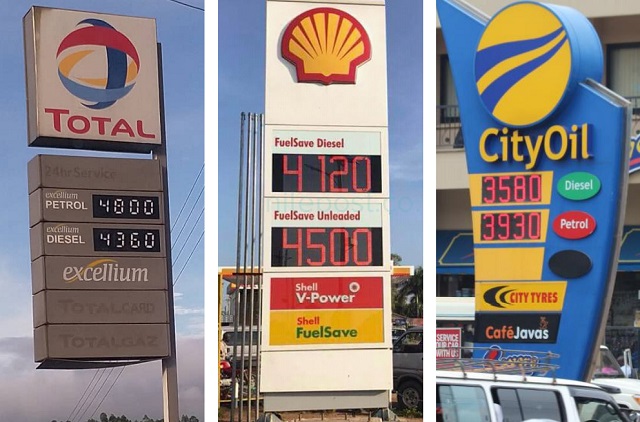
Kampala, Uganda | THE INDEPENDENT | Fuel prices in Kampala and beyond have continued to skyrocket, but more sharply over the last two months.
A litre of fuel currently stands between 5,550 and 5,700 shillings, while the price of diesel at some stations is the same as petrol.
Over the months, there has also been a change in the pattern of pricing with smaller marketers setting the same or even higher prices than the two market leaders; TotalEnergies and Shell.
The rapid increase in global prices recently has also resulted in greater variations in prices from station to station.
An official from the Ministry of Energy and Mineral Development who preferred anonymity said because of the global supply disruptions, most companies are getting fuel in smaller amounts, hence the volatility and higher prices.
The ministry says they have no ability to control the effects on fuel since they are largely caused by external factors.
“The factors affecting fuel prices are mostly external and not internal. As the ministry in charge, we shall keep monitoring what is happening in the international market and supply chain. We are sure that when the market stabilizes, the local industry will also stabilize,” said head of communication Solomon Muyita.
Ugandans are also advised to brace themselves for further disruptions as Kenya, the route for more than 80 percent of Uganda’s fuel and other imports, goes to the polls in August.
The country is worried about possible disruptions in supply by election and post-election violence which characterized a similar process in 2007/8 when cargo destined to Uganda was either blocked or destroyed.
The State Minister for Finance, Henry Musasizi has already said that they are preparing to ship imports through Tanzania, a longer and more expensive route, which would affect the cost of products.
“We are not saying there will be violence, we are saying there is a political risk because of the August elections in Kenya and how do we ensure that we don’t get supply disruptions? We are saying that should it happen, there should be an alternative” the minister said.
He says procurement of water vessels is ongoing to connect Mwanza port to the ports in Kampala and Jinja.
“We have procured vessels which can be used to transport fuel to Kampala just in case. Even when there is no political risk, we feel it is better management to have options,” Musasizi said.
The Bank of Uganda now predicts a continued worsening foreign exchange rate. As the dollar rate moves towards 3,900 shillings, this will even put more pressure on the price of imported fuel products since it will require to spend more shillings so as to get the required dollars to buy the imports.
Kenya, Tanzania, Rwanda, the Democratic Republic of Congo and Ethiopia have all either introduced or increased subsidies on fuel product costs to help contain the rising prices. Uganda maintains it will neither offer subsidies nor reduce taxes saying it is dangerous for the economy.
Tanzania, which earlier in the month announced subsidies worth 43 million dollars (160 billion Uganda shillings), has now announced a reduction in prices effective this week.
The retail price for petrol is 2,994 Tanzania shillings (4,820 Uganda shillings), while the price of diesel now drops to an equivalent 5040 Uganda shillings, according to the Energy and Water Utilities Regulatory Authority (EWURA).
The sharp increase in petroleum product prices is also leading to record inflation rates, with the latest at the end of May 2022, being recorded at 6.3 percent.
According to the Uganda Bureau of Statistics, the price of diesel increased by 54 percent by end of May 2022, while petrol recorded an increase of 30 percent.
Apart from the local and regional factors, prices of fuel are mainly driven by the changes in the prices of crude oil in the international market.
“Every 10-dollar increase in the cost of a barrel of crude adds almost a quarter to the price of a gallon (3.78 litres) at the pump,” according to US magazine CNET while explaining the effect of the Russia-Ukraine conflict on global prices.
“Even though the US doesn’t import much crude from Russia, oil is traded on a global market, and any ripple affects prices all over the world,” the report says.
The new spike in global crude prices resulted from the European Union’s proposal last week to cut off Russian oil.
The current crisis has become more complex because of the several factors that have contributed to the current price increases.
The war in Ukraine started when the demand for petroleum had already outstripped the supply.
Oil companies were reducing investments in new projects, under pressure from falling prices on one hand, and shareholders demanding higher returns on the other.
Demand plummeted during the Covid 19 pandemic period, causing oil producers to stop production, as crude prices fell to zero.
When economies started to reopen, refineries around the world under-estimated how quickly demand would pick up and therefore, did not plan accordingly.
Since then, even as demand has been rising sharply, the crude producers have been reluctant to increase output to bridge the deficit, and experts say this might continue even beyond the Ukraine conflict.
In most countries, at least in Africa, diesel is known to be cheaper than petrol, but recently there is a mixed picture, with diesel prices rising faster than those of fuel.
On the global scene, the US and UK, as well as some other countries in the west, they rely on more diesel from Russia than petrol.
Due to the sanctions on Russia, they are increasingly looking for diesel purchases from elsewhere, putting pressure on the demand for diesel.
*****
URN
 The Independent Uganda: You get the Truth we Pay the Price
The Independent Uganda: You get the Truth we Pay the Price




The high fuel prices have led to increase in food prices.